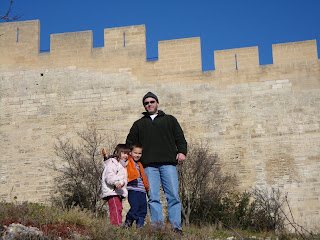Avignon is one of the major cities of Provence, in Southern France. It is located on the banks of the Rhône river. Avignon is famous as the city to which the Popes fled when leaving the corruption of Rome in the 14th century. The Palais they built, 'Le Palais des Papes,' is the world's largest Gothic edifice. It was largely emptied over the centuries, and its vast stone rooms are filled with little more than old frescos, but it is still an imposing building. The Ramparts themselves were erected to keep the plague and invaders out during the turbulent middle ages, when Avignon belonged to the papacy and not the French crown. It is estimated that about 200,000 people live in Avignon, 16,000 of which live 'intra-muros,' or within the ramparts built in the 14th century. Avignon has been continuously inhabited since the stone age, when troglodyte inhabitations were built in caves in the Rocher des Dames, a massive outcropping of rock rising over the banks of the Rhône. The Romans had a presence in Avignon, though the walls they built lie buried somewhere under the modern streets.
The stone bridge spanning the Rhone was one of only three between the Mediterranean and Lyon. It was undoubtedly for its strategic location and ease of travel that it was chosen by the papacy as home within the then kingdom of Provence. The presence of the papacy made Avignon into a city of great political and economic activity. We spent the afternoon exploring the main sites of the city, which included the Palace of the Popes, the Cathedral, and the stone bridge described above. We did an audio tour of the palace and bridge.
The story behind the bridge is an interesting one: after completion of the cathedral, a large stone was left over that could not be moved. A young shepard received a message from God that he was to build the bridge. The idea was laughed off by the leaders of the city who told the shepard that if this was a request from God, then move the huge boulder and lay the first stone. Without hesitation the boy picked up the stone and hurled it into position. The leaders seeing this miracle believed that it was truly the will of God and provided the resources to build the bridge. The shepard was canonized as St. Benedict. We had a nice meal in the old city called Les Artistes. Sandy had a traditional dish called La bouillabaisse. La bouillabaisse is an excellent fish-based soup served with la rouille (a garlic-saffron sauce) and bread similar to crostini. After the soup comes the fish...delicious.









